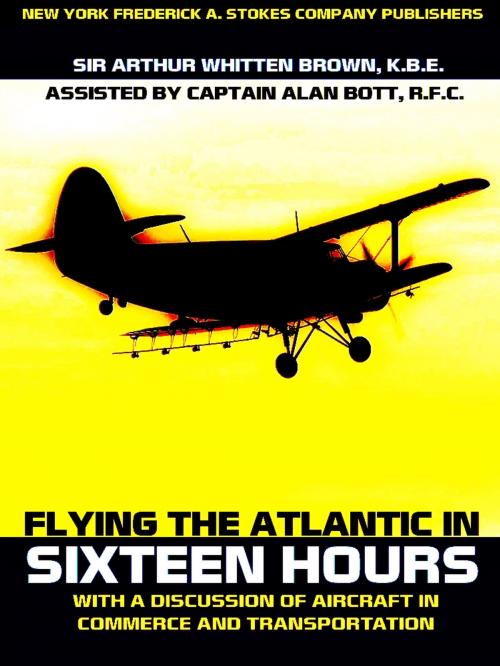Flying the Atlantic in Sixteen Hours
With a Discussion of Aircraft in Commerce and Transportation (Illustrations)
Nonfiction, Travel, Polar Regions, Adventure & Literary Travel, Biography & Memoir| Author: | Arthur Whitten Brown, Alan Bott | ISBN: | 1230000275145 |
| Publisher: | NEW YORK FREDERICK A. STOKES COMPANY | Publication: | October 20, 2014 |
| Imprint: | Language: | English |
| Author: | Arthur Whitten Brown, Alan Bott |
| ISBN: | 1230000275145 |
| Publisher: | NEW YORK FREDERICK A. STOKES COMPANY |
| Publication: | October 20, 2014 |
| Imprint: | |
| Language: | English |
Example in this ebook
CHAPTER I
Some Preliminary Events
"After me cometh a builder. Tell him I, too, have known."
Kipling.
It is an awful thing to be told that one has made history, or done something historic. Such an accusation implies the duty of living up to other people's expectations; and merely an ordinary person who has been lucky, like myself, cannot fulfil such expectations.
Sir John Alcock and I have been informed so often, by the printed and spoken word, that our achievement in making the first non-stop transatlantic flight is an important event in the history of aviation that almost—but not quite—I have come to believe it. And this half-belief makes me very humble, when I consider the splendid company of pioneers who, without due recognition, gave life, money or precious years, often all three, to further the future of aëronautics—Lilienthal, Pilcher, Langley, Eiffel, Lanchester, Maxim, the Wrights, Bleriot, Cody, Roe, Rolls and the many daring men who piloted the weird, experimental craft which were among the first to fly.
I believe that ever since Man, but recently conscious of his own existence, saw the birds, he has desired to emulate them. Among the myths and fables of every race are tales of human flight. The paradise of most religions is reached through the air, and through the air gods and prophets have passed from earth to their respective heavens. And all authentic angels are endowed with wings.
The present generation is lucky in that, despite this instinctive longing since the beginning of human history for the means of flight, it is the first to see dreams and theories translated into fact by the startling development of practical aviation, within the past fifteen years. The aëronautical wonders of the next fifteen years are likely to be yet more startling.
Five years ago, before the offensive and defensive needs of war provided a supreme raison d'être, flying was but a costly and dangerous pastime. As such it attracted the first-class adventurers of every race, many of whom lost their lives on weird, Jabberwock-like aircraft, built and tested before experimental data and more accurate methods of calculation became available.
But even these men could not realize the wonderful possibilities of the coming air age, of which they were the pioneers. Nearly all the early aëroplanes were born of private enterprise, for capitalists had no faith in the commercial future of flight. Very few firms applied themselves solely to the manufacture of aircraft or aëro engines, and only two or three of the great engineering companies had the vision to maintain aëronautical departments.
Among the few important companies that, in those days, regarded aëronautics seriously was Messrs. Vickers, Ltd. They established an experimental department, and as a result of its work began to produce military types of aircraft which were in advance of their period. Later, when the whirlwind of war provided the impetus which swept pioneer aviation into headlong progress, the Vickers productions moved with the times, and helped largely to make the British aircraft industry the greatest in the world. Now that aviation has entered into the third phase of its advance—that of a peace-time commercial proposition—they are again in the forefront of production. Incidentally they provided me with the greatest chance of my life—that of taking part in the first non-stop flight across the Atlantic. Since then a Vickers aëroplane has won yet another great distinction—the prize for the first flight from England to Australia.
To be continue in this ebook...............................................................................................................
Example in this ebook
CHAPTER I
Some Preliminary Events
"After me cometh a builder. Tell him I, too, have known."
Kipling.
It is an awful thing to be told that one has made history, or done something historic. Such an accusation implies the duty of living up to other people's expectations; and merely an ordinary person who has been lucky, like myself, cannot fulfil such expectations.
Sir John Alcock and I have been informed so often, by the printed and spoken word, that our achievement in making the first non-stop transatlantic flight is an important event in the history of aviation that almost—but not quite—I have come to believe it. And this half-belief makes me very humble, when I consider the splendid company of pioneers who, without due recognition, gave life, money or precious years, often all three, to further the future of aëronautics—Lilienthal, Pilcher, Langley, Eiffel, Lanchester, Maxim, the Wrights, Bleriot, Cody, Roe, Rolls and the many daring men who piloted the weird, experimental craft which were among the first to fly.
I believe that ever since Man, but recently conscious of his own existence, saw the birds, he has desired to emulate them. Among the myths and fables of every race are tales of human flight. The paradise of most religions is reached through the air, and through the air gods and prophets have passed from earth to their respective heavens. And all authentic angels are endowed with wings.
The present generation is lucky in that, despite this instinctive longing since the beginning of human history for the means of flight, it is the first to see dreams and theories translated into fact by the startling development of practical aviation, within the past fifteen years. The aëronautical wonders of the next fifteen years are likely to be yet more startling.
Five years ago, before the offensive and defensive needs of war provided a supreme raison d'être, flying was but a costly and dangerous pastime. As such it attracted the first-class adventurers of every race, many of whom lost their lives on weird, Jabberwock-like aircraft, built and tested before experimental data and more accurate methods of calculation became available.
But even these men could not realize the wonderful possibilities of the coming air age, of which they were the pioneers. Nearly all the early aëroplanes were born of private enterprise, for capitalists had no faith in the commercial future of flight. Very few firms applied themselves solely to the manufacture of aircraft or aëro engines, and only two or three of the great engineering companies had the vision to maintain aëronautical departments.
Among the few important companies that, in those days, regarded aëronautics seriously was Messrs. Vickers, Ltd. They established an experimental department, and as a result of its work began to produce military types of aircraft which were in advance of their period. Later, when the whirlwind of war provided the impetus which swept pioneer aviation into headlong progress, the Vickers productions moved with the times, and helped largely to make the British aircraft industry the greatest in the world. Now that aviation has entered into the third phase of its advance—that of a peace-time commercial proposition—they are again in the forefront of production. Incidentally they provided me with the greatest chance of my life—that of taking part in the first non-stop flight across the Atlantic. Since then a Vickers aëroplane has won yet another great distinction—the prize for the first flight from England to Australia.
To be continue in this ebook...............................................................................................................















